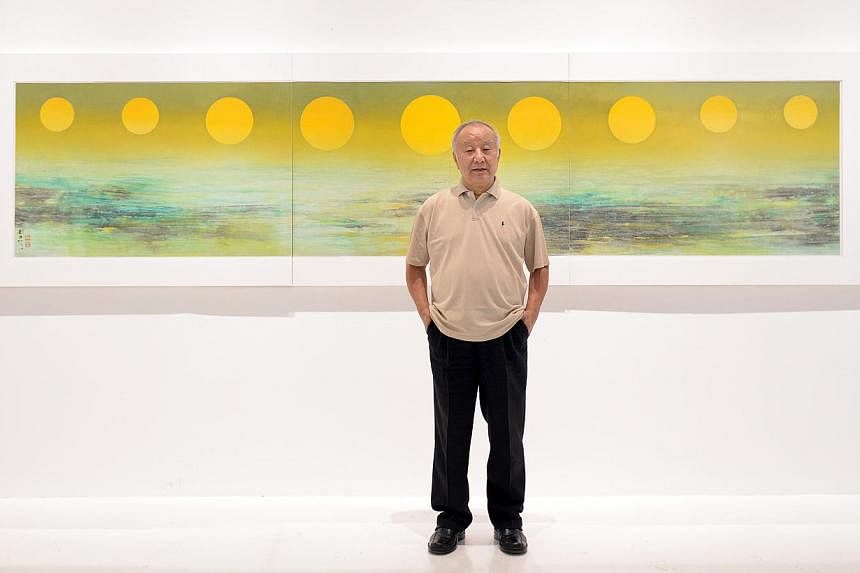When Chinese artist Liu Kuo-sung was in his 20s, he started experimenting with materials and techniques that would earn him the "father of modern Chinese ink painting" moniker that he still carries today.
One of his innovations back in the 1950s is the ink-soaking method, where he uses a dry brush to rearrange bubbles formed between two damp pieces of paper before dripping paint, ink and water on them.
When the ink dries, the papers are separated and the resulting patterns form the skeleton around which he paints the sweeping, snow-capped mountains and vast, shimmering lakes that feature prominently in his works.
Later in 1963, he created "Liu Kuo-sung paper" by incorporating rough bark fibres in paper used to make Chinese lanterns. When painted on, the fibres block the ink, creating a dense, intricate mesh of criss-crossing white lines unique to his works.
These experiments were born out of frustration, the spry 83-year-old tells Life! during an hour-long interview at the Museum of Contemporary Arts @ Loewen, where he is displaying more than 80 of his recent artworks till March 1.
Speaking in Mandarin, he says: "When I was studying Western painting and the greats such as Matisse and Picasso, I realised that traditional Chinese painting was getting blander by the generation. There was no creation, no innovation, so I felt the need to do something."
Born in Anhui, China, Liu emigrated to Taiwan in 1949 after the Chinese Civil War. It was there that he studied and practised fine arts, first learning traditional ink painting before turning to abstract art.
In 1966, he won a two-year world travel grant from the John D. Rockefeller III Foundation and headed to the United States. Three years later, he used his techniques to great effect to produce his Space series, inspired by other-worldly images of the Earth and Moon transmitted from the Apollo 8 spaceship.
His career has spanned more than six decades in the art world. A glance at his curriculum vitae yields a five-page list of achievements - he has received top art accolades on both sides of the Taiwan Strait, while his artworks are collected and shown in more than 70 countries.
Last November, his 12m-long Scenery Of Hong Kong handscroll was auctioned off in Hong Kong for HKD16.8 million (S$2.93 million).
Despite his age, Liu does not intend to stop - painting has become his nightly ritual. He says with a smile: "It's been my habit for the past 50 years. I have low blood pressure and it's been said such people are more active at night. I intend to paint till I'm 100."
Despite losing the hearing in his left ear from altitude sickness during a trip to Tibet in 2000, he remains undeterred.
"I was depressed at first, but I thought, I still have one functioning ear. I can just turn my deaf left ear to scoldings from now on," he adds.
It has not affected his work as he paints by tapping feelings deep in the recesses of his mind, he explains.
"When I see something, I experience and take it all in. I don't take photographs or paint realistically. I feel and create my interpretation," says Liu, recounting how he rose at dawn to witness the "heavenly" sight of the morning sun climbing out of the lake in Jiuzhaigou during a trip to the scenic valley in China's south-western Sichuan province in the noughties.
During the interview, he sits perfectly straight, regal in his bearing, and speaks in a spirited, sonorous boom.
"I treat art like a game of chess. You have to take one step at a time and adapt. I don't paint with a well thought-out plan," he explains, using a poetic idiom dating back to the Song dynasty (960-1279), which translates roughly to "bamboo imprinted on the mind".
Liu counts painters from that era such as Liang Kai and Shi Ke, famous for their po mo, or thrown ink, painting style, among his influences. Po mo is a way of painting spontaneously, without any guiding sketches or outlines, to express the inner self.
"They were the first abstract artists before the Renaissance came along. Chinese painting was so far ahead of the West then," he says.
His wife, Li Mo-hua, 79, a retired plant pathologist, says: "He's very brave and open. Even when times were bad and no one was buying art, he kept going. He said to me: 'I may be poor forever, but this is my ambition.'"
The days of hardship are over and they now reside in Taoyuan, Taiwan, where Liu is a chaired professor at the fine arts department in the National Taiwan Normal University. They have two daughters and a son, as well as six grandchildren.
He gives the following advice to his students: "I always tell them, seek first originality, then quality. You have to find your own style and have a personal way of doing things to be an artist."


